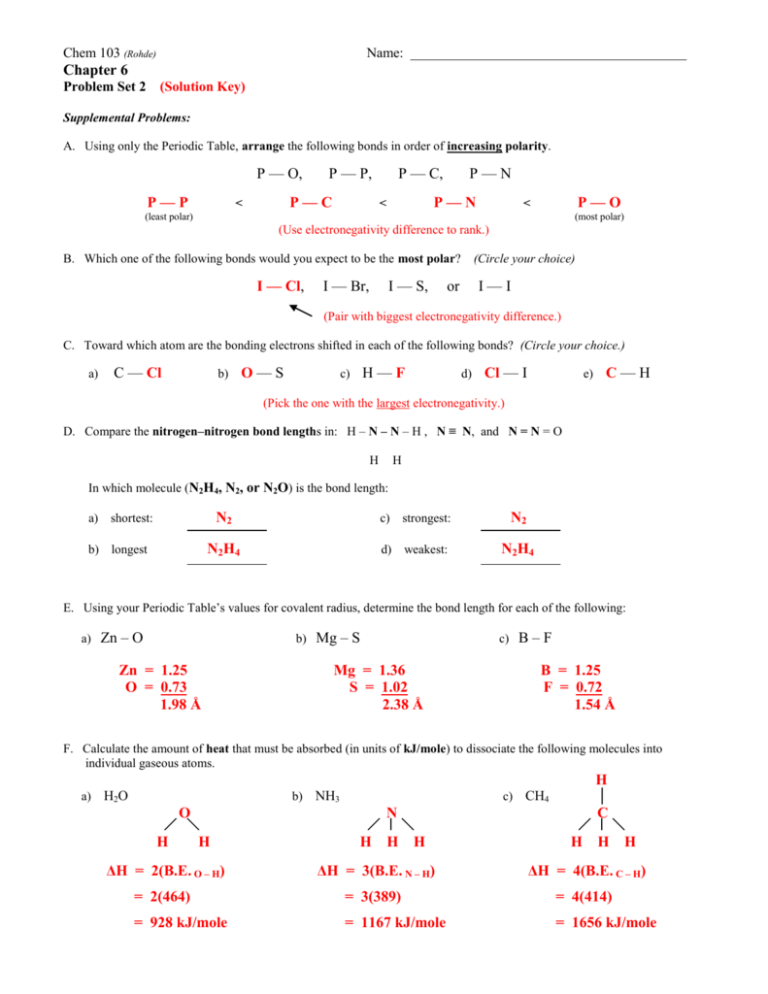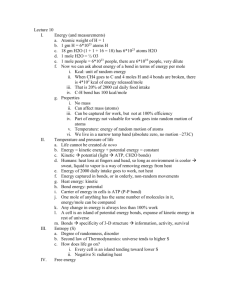Chem 103 (Rohde)
advertisement

Chem 103 (Rohde) Name: ________________________________________ Chapter 6 Problem Set 2 (Solution Key) Supplemental Problems: A. Using only the Periodic Table, arrange the following bonds in order of increasing polarity. P — O, P—P P — P, P—C < P — C, P—N P—N < P—O < (least polar) (most polar) (Use electronegativity difference to rank.) B. Which one of the following bonds would you expect to be the most polar? I — Cl, I — Br, I — S, (Circle your choice) I—I or (Pair with biggest electronegativity difference.) C. Toward which atom are the bonding electrons shifted in each of the following bonds? (Circle your choice.) a) C — Cl b) O—S H—F c) d) Cl — I e) C—H (Pick the one with the largest electronegativity.) D. Compare the nitrogen–nitrogen bond lengths in: H – N – N – H , N ≡ N, and N = N = O H H In which molecule (N2H4, N2, or N2O) is the bond length: a) N2 c) strongest: N2 N2 H 4 d) weakest: N2H4 shortest: b) longest E. Using your Periodic Table’s values for covalent radius, determine the bond length for each of the following: a) Zn – O b) Zn = 1.25 O = 0.73 1.98 Å Mg – S c) Mg = 1.36 S = 1.02 2.38 Å B–F B = 1.25 F = 0.72 1.54 Å F. Calculate the amount of heat that must be absorbed (in units of kJ/mole) to dissociate the following molecules into individual gaseous atoms. H a) H2O b) NH3 c) O H │ CH4 N H H H C H H H H ΔH = 2(B.E. O – H) ΔH = 3(B.E. N – H) ΔH = 4(B.E. C – H) = 2(464) = 3(389) = 4(414) = 928 kJ/mole = 1167 kJ/mole = 1656 kJ/mole G. Using bond energies, estimate ΔH for the reaction: Cl – Cl Cl2 (g) + 3 F2 (g) → 3(F–F) + → 2 ClF3 (g) 2 ( F – Cl – F ) │ F Break: One Cl – Cl bond, and three F – F bonds Form: Six Cl – F bonds ΔH = B.E. Cl – Cl + 3 (B.E. F – F ) – = 243 = + 3 (153) – 6 (B.E. Cl – F ) 6 (255) – 828 kJ/mole H. Using bond energy tables, estimate ΔH for the reaction: [Hint: The correct Lewis structure for C2H2 is helpful!] H–C ≡ C–H + C2H2 (g) 2 Br2 (g) → 2 ( Br – Br ) → C2H2Br4 (g) Br Br │ │ H–C–C–H │ │ Br Br When the reaction is written with structural formulas, we can see that the triple bond in C2H2 is ―broken‖, and replaced with a single bond. When the triple bond ―opens up‖, bond sites for the four bromine atoms are available. So, we must break the triple bond between carbon atoms, and break two Br – Br bonds. Then form a single bond between carbon atoms, and four C – Br bonds: ΔH = B.E. C ≡ C + 2 (B.E. Br – Br ) – (B.E. C – C ) – = 820 + 2 (193) – = – 245 kJ/mole (347) – 4 (276) 4 (B.E. C – Br )








